Brian Zinchuk is editor and owner of Pipeline Online
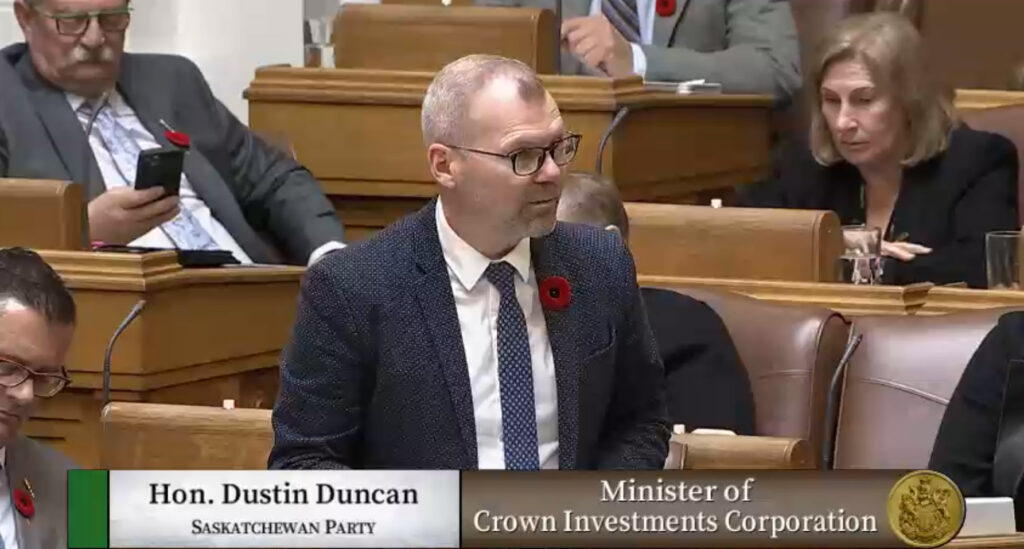
Dustin Duncan on Oct. 30. Legislative Assembly of Saskatchewan
On Nov. 2, the Province of Saskatchewan and SaskPower made their submissions to the federal government regarding the proposed Clean Electricity Regulations, which seek to drive Canada to have “Net Zero by 2035” greenhouse gas emissions from power generation.
If carried out in their current form, Saskatchewan would have to shut down all its conventional coal power by 2030, and implement carbon capture on its natural gas power generation fleet to a standard that is nearly five times more stringent than the design specs were for the Boundary Dam Unit 3 Carbon Capture Project. SaskPower says those carbon capture efficiency standards have never been accomplished on commercial scale natural gas, and the parasitic loss of power to run the carbon capture would be 25 per cent.
On Nov. 21, Minister of Crown Investments Corporation (which includes SaskPower and SaskEnergy) Dustin Duncan publicly released the province’s response, below in PDF form
SaskPower CER Response_Appendix_November 2 2023
Guilbeault correspondence re-SK response to CER 11-2-23
2023-11-02 Letter and Appendix Campbell to ECCC CER Technical Submission
Pipeline Online spoke to Duncan in depth about this response. Here is that conversation:
Pipeline Online: Between your letter and SaskPower’s letter, it’s clear the Clean Electricity Regulations are all but impossible to follow for this province. What happens if the federal government carries on, without substantial changes to these regulations?
Dustin Duncan: Well, I mean, what we said to the federal government is that what they’re proposing is just not possible for the province of Saskatchewan. What they’ve outlined in the CER draft regulations just would not be possible for us to achieve and so that’s why we’re asking the federal government to go back to the drawing board. This is not going to work for us.
Their modeling isn’t established enough to actually look at what the regulations would do to Saskatchewan. So we’re asking them to refine their modeling or actually do better modeling, and work with us, we’ve said that 2050 is our time timeline. So it’s not a discussion about really reducing emissions. It’s really, how do you do it? And then what timeframe?
And so you know, I don’t know what really happens at 2035. But what we do know is that what they’re asking for, it just isn’t possible.
Pipeline Online: Minister Steven Guilbeault has already suggested there would be criminal implications for not following through. It sounds like you, personally, (or your successor), as the minister responsible, could be held to account for withholding the carbon tax with SaskEnergy, and perhaps the CER. Is there really anything to that, or is it just bluster?
Dustin Duncan: Well, I certainly hope it’s not bluster from the federal government standpoint. I would hope that they wouldn’t use the threat of criminal charges to force a jurisdiction like Saskatchewan to do something that we just technically, logistically and from an affordability perspective, particularly for low income Saskatchewanians do something that we just can’t do.
So, again, we’re willing to work with the federal government to do modeling and show the work that we’ve done in our presentation; both from a technical aspect, as well as what I’ve provided to the federal minister. We’re more than willing to work with them to show them why this just is not achievable for Saskatchewan, and what our plan is going forward. So, we certainly hope it doesn’t get to the point where, come 2035, when we haven’t been able to meet what they’ve set out in the draft regulations, that there would be any threats of criminal charges or anything like that.
So we’re, we want to work with them and show them why this is impossible, and that we do have a plan in Saskatchewan. But what they put forward is just not possible for us.
Pipeline Online: And you just alluded to this – both your letter and SaskPower’s say Saskatchewan could reach Net Zero by 2050. But there’s no explanation of that. SaskPower acknowledges that wind output drops to zero, and of course, solar drops to zero every night. So what is the plan? What can we do in the 15 years from 2035-2050 that will get us to next zero? Are we going to build five or more large scale, 1,000 megawatt reactors in that time?
Dustin Duncan: Yeah, I think the farther out you go, the more difficult it is to be precise on what technology we will be utilizing. But we know this, that Saskatchewan is growing. Our population is forecast to grow by another 200,000 people by the end of 2030 and our economy continues to grow. And there’s more and more electrification occurring in the economy every year.
And so, we know that we’re going to have to expand our capacity in terms of generating electricity. But again, the actual way that we’re going to do that it gets less precise over time.
But we do know what we can do, that is by continuing to expand the use of natural gas as a part of baseload power, and looking at, in this instance, small modular reactors that we’re on a path to make that decision over the next couple of years, of whether or not we’re going to proceed down that road. And as our requirements for electrical generation grow, there may be a time in the future where we may have to consider or need to consider a larger scale conventional type of nuclear as a part of the electricity profile.
But, but for now, it’s baseload power through natural gas, the potential for SMRs, and then see what technology is available, available as we get closer to 2050.
- 0108 Steffes Auctioners Western Canadian Pipeline0108 Steffes Auctioners Western Canadian Pipeline
- 0107 Steffes Auctioners Western Canadian Pipeline Completion0107 Steffes Auctioners Western Canadian Pipeline Completion
- 0106 SASPO-2874_Self Serve Campaign_New Connects_Youtube_v30106 SASPO-2874_Self Serve Campaign_New Connects_Youtube_v3
- 0105 SaskEnergy Commitment to Safety0105 SaskEnergy Commitment to Safety
- 0102 Lori Carr Coal Extended0102 Lori Carr Coal Extended
- 0100 Turnbull Project Manager0100 Turnbull Project Manager
- 0099 Mryglod Steel 1080p0099 Mryglod Steel 1080p
- 0097 Eagle Sky Ventures LTD0097 Eagle Sky Ventures LTD
- 0095 Fast Trucking nearly 70 years good at it0095 Fast Trucking nearly 70 years good at it
- 0092 Turnbull projects big and small0092 Turnbull projects big and small
- 0046 City of Estevan This is Estevan Teaser0046 City of Estevan This is Estevan Teaser
- 0077 Caprice Resources Stand Up For Free Speech0077 Caprice Resources Stand Up For Free Speech
- 0061 SIMSA 2024 For Sask Buy Sask0061 SIMSA 2024 For Sask Buy Sask
- 0051 JML Hiring Pumpjack assembly0051 JML Hiring Pumpjack assembly
- 0049 Scotsburn Dental soft guitar0049 Scotsburn Dental soft guitar
- 0041 DEEP Since 2018 now we are going to build0041 DEEP Since 2018 now we are going to build
- 0032 IWS Summer hiring rock trailer music
- 0022 Grimes winter hiring
- 0021 OSY Rentals S8 Promo
- 0018 IWS Hiring Royal Summer
- 0013 Panther Drilling PO ad 03 top drive rigs
- 0002 gilliss casing services0002 gilliss casing services
- 9002 Pipeline Online 30 sec EBEX9002 Pipeline Online 30 sec EBEX
- 9001
Pipeline Online: The detailed SaskPower submissions on the Clean Electricity Regulations talk about two small modular reactors, each 315 megawatts. When your predecessor, Don Morgan, made the initial announcement about 18 months ago, he spoke of 4. This last August, he mentioned we might need up to 9. And Premier Scott Moe spoke to me in August of the possibility of 1,000 megawatt reactors. On Monday, you signed a master services agreement with Laurentis/Ontario Power Generation (OPG). How many reactors was that for, what is the ultimate number, and what are the timelines?
Dustin Duncan: Ultimately, the timeline is 2029 for deciding whether or not to build our first SMR.
I would say that a lot of this is going to depend on site selection. So we’re going through that process now, where by next year, within those two study areas, we would be in a position to designate the site that we would submit as a part of our application.
The Laurentis master service agreement doesn’t dictate a number or a timeline. What that really does is allow SaskPower to tap into the expertise as they move through the regulatory process.
And so what we would be looking at is, what SaskPower would be looking at is to essentially, in order for us to derisk, both from a financial perspective as well as a timeline perspective we need. While SaskPower has a small team that is on the SMR project, we need to further establish that working relationship with an organization like OPG and their company, Laurentis, to really tap into that expertise as we embark upon the regulatory process, all the submissions that will be necessary to get us to a point.
So the master service agreement doesn’t specify a number, in terms of how many SMRs, and I would say at this point, we’re looking at making a decision on our first one by 2029. But, I think in terms of the numbers, that’ll be dictated over time. If we do proceed down the first one, it would be unlikely to build a single reactor. So whether that first one is two or four, there will be a number of factors that would determine that.
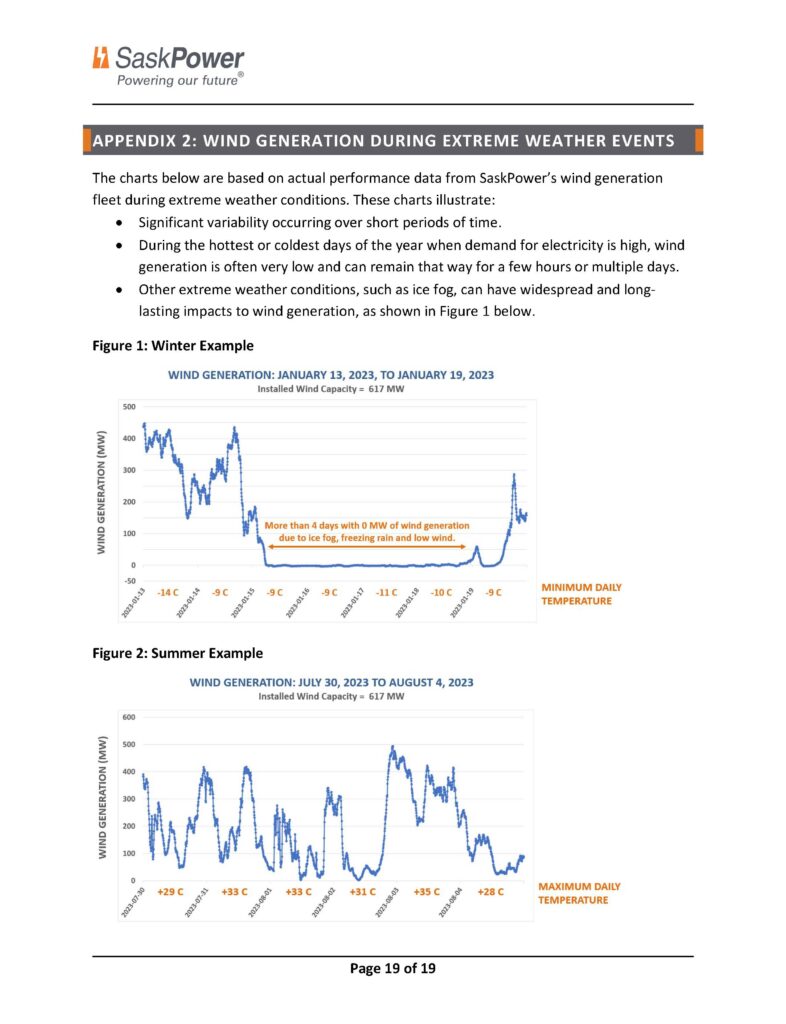
In its response to the federal government, SaskPower laid out real world occurences of wind power generation flatlining for four days in January, and multiple times in August. SaskPower
- 0108 Steffes Auctioners Western Canadian Pipeline0108 Steffes Auctioners Western Canadian Pipeline
- 0107 Steffes Auctioners Western Canadian Pipeline Completion0107 Steffes Auctioners Western Canadian Pipeline Completion
- 0106 SASPO-2874_Self Serve Campaign_New Connects_Youtube_v30106 SASPO-2874_Self Serve Campaign_New Connects_Youtube_v3
- 0105 SaskEnergy Commitment to Safety0105 SaskEnergy Commitment to Safety
- 0102 Lori Carr Coal Extended0102 Lori Carr Coal Extended
- 0100 Turnbull Project Manager0100 Turnbull Project Manager
- 0099 Mryglod Steel 1080p0099 Mryglod Steel 1080p
- 0097 Eagle Sky Ventures LTD0097 Eagle Sky Ventures LTD
- 0095 Fast Trucking nearly 70 years good at it0095 Fast Trucking nearly 70 years good at it
- 0092 Turnbull projects big and small0092 Turnbull projects big and small
- 0046 City of Estevan This is Estevan Teaser0046 City of Estevan This is Estevan Teaser
- 0077 Caprice Resources Stand Up For Free Speech0077 Caprice Resources Stand Up For Free Speech
- 0061 SIMSA 2024 For Sask Buy Sask0061 SIMSA 2024 For Sask Buy Sask
- 0051 JML Hiring Pumpjack assembly0051 JML Hiring Pumpjack assembly
- 0049 Scotsburn Dental soft guitar0049 Scotsburn Dental soft guitar
- 0041 DEEP Since 2018 now we are going to build0041 DEEP Since 2018 now we are going to build
- 0032 IWS Summer hiring rock trailer music
- 0022 Grimes winter hiring
- 0021 OSY Rentals S8 Promo
- 0018 IWS Hiring Royal Summer
- 0013 Panther Drilling PO ad 03 top drive rigs
- 0002 gilliss casing services0002 gilliss casing services
- 9002 Pipeline Online 30 sec EBEX9002 Pipeline Online 30 sec EBEX
- 9001
Pipeline Online: SaskPower’s CER submissions elaborate on the buildout of a further 3,000 megawatts of wind and solar by 2035, and allude to the need for natural gas backup. And those same submissions point out four days of zero wind production last winter. But the submissions don’t discuss a buildout of 3,000 megawatts of natural gas as backup in a similar time frame. Why is that? Are we going to build additional natural gas plants to back up wind and solar one-for-one? And if not, what happens when we have days like Jan. 15-19, with no wind power?
Dustin Duncan: We know we need baseload to incorporate any number of renewables into the system. And so, while we are looking at natural gas to be a big part of our baseload going forward, obviously SMR will be a part of that conversation.
And so we don’t really designate what the 3,000 megawatts would be as a part of the submission because, again, the further out you get from basically today, it’s we’re less precise and knowing what that baseload would be, but I would say it would be any combination of natural gas, our intertie ability to import power, the potential, yes, for SMRs, and other baseline baseload generation into the future. So, again, the further away you get, it’s harder to know what exactly technology that would be, but we know that it has to be baseload.

Western Lily Wind Power Facility at Grenfell on July 7, 2023. Photo by Brian Zinchuk
Pipeline Online: A strong case is made regarding the unreliability of wind power, and the need for natural gas backup. Additionally, the sun going down each night means the same for solar. So really, we’d be building two, duplicate power systems, and actually three, if you count solar. How is this in any way affordable? Why not just spend all that money on nuclear, which is much more reliable?
Dustin Duncan: So, I think it’s good, because it’s going have to be all options have to be on the table. We know that there certainly is continued demand, particularly from industrial customers that want to see more of a balanced portfolio, ensuring that there’s baseload, but also that there is renewable capacity. And we know that the cost is competitive at this point. And so, we know that over the long term, we’re just going to have to build more, and I think it’s going to be a combination of a number of different things.
Pipeline Online: SaskPower talks about building 400 megawatts of grid scale batteries. But Alberta already has 130 megawatts across seven sites. They each supply power, on average, three times a month, typically for 9 to 23 minutes at a time. Is this what we’re going to be building?
Dustin Duncan: No, no, it will be a piece, but I would say overall, it’ll be a small piece of the picture.
We’re looking to build baseload generation. We know that our province requires that our industries in the province require that it needs to be it needs to be affordable. And so, that’s why we’re looking at building additional, whether it be natural gas, or looking at nuclear, both small modular right now, but also the potential for large scale down the road. But we know we need baseload generation, that’s where our generation is going to come from.
Pipeline Online: Maybe you didn’t hear me clearly. I was referring to batteries. The plans in the submissions talk about 400 megawatts of batteries.
Dustin Duncan: And I’m saying that there will be, as storage technology improves, we’ll be looking to incorporate some of that, but it’s just not in large scale. It’s not, I would say, largely deployed anywhere. It’s still being proven technology. And so, it would account for a very small portion of the overall capacity within the system.
Pipeline Online: SaskPower’s submissions do not go into great depth on how it would increase the size of the electrical grid by a factor of 2.5x by 2050, as the CER expect will be necessary. How will we accomplish this, in that time frame, when jurisdictions around the world are working on a similar buildout? Where will we get the pylons, transformers, wires and the like to do this?
Dustin Duncan: And that’s part of why we are raising serious concerns with the with the CER.
Everybody trying to do this by 2035 is going to put significant pressure on all of us, on supply chain, on workforce. It’s going to be inflationary, as we’re all trying to do it at the same time. 2050 is going to be challenging in and of itself. So, to speed up those timelines to 2035, just again reiterates our point, that this is just not possible and not feasible.
Stretching our timelines out to 2050, that does allow us to, as more and more generation is brought onto the grid, but also as more electrification takes place, and there is more demand on the on the electrical grid, that does give us the time to work with our supply chain networks, to work with post secondary to ensure that we have a workforce in this province that can that can supply employees to the industry.
And so, I think your question raises a good point. You know, there’s going be a lot of work that’s going to go into building out the supply network, the supply chain, by 2050. Not going to be hard enough. 2035 just isn’t on for us. And frankly, it’s not on for anybody else. And that’s why the Canadian Electricity Association. they’ve also submitted to the federal government all the utilities are on the same page on this.
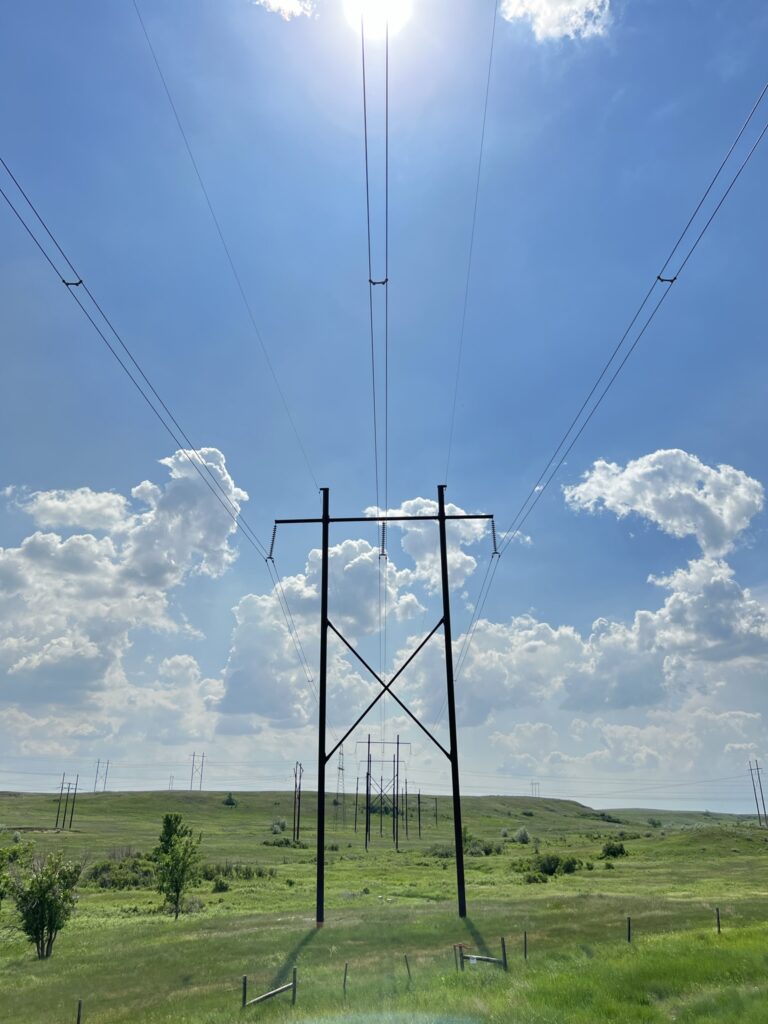
Doubling or tripling the electrical grid doesn’t just mean power generation, but transmission lines like these coming out of Boundary Dam Power Station, and distribution to every house and business in the country. All in 27 years. Photo by Brian Zinchuk
Pipeline Online: Saskatchewan’s submissions talk about power rates going up by 107% by 2035. But if we have to build out our grid – generation, transmission and distribution, by a factor of 2.5x in 26 years, and replace nearly all of our generation in 11 years, wouldn’t we need an awful lot more money than that? Wouldn’t power rates go up a lot more than 107%?
Dustin Duncan: That’s really looking at the CER and, frankly, other stacking that’s taken place in terms of federal regulations. And that’s by 2035. Would there need to be rate adjustments beyond 2035? Obviously, we would have to expand out the generation beyond 2035 and upgrade the grid as you’re talking about, in terms of what more of a full electrification of the economy looks like. It gets harder to forecast out beyond 2035. This is what we’re responding to, though. We’re responding specifically to the CER regulations that speak to now, until 2035. So, we know that the regulations alone, look at in our in our view, at least 107% increase in rates.
Now at the same time, though, we’re expecting that the province will continue to grow. An additional 200,000 people will live in the province and more by 2030, and then beyond. And so you know, we would spread that out, over essentially having more people in the province, more people paying.
But the change in how we are going to generate electricity in this province, it is it is not going to come without cost. And that’s why we’re asking the federal government, for instance, on the first SMR, provide 75 per cent of the capital costs, because you’re forcing us to make these decisions, then you need to put some serious skin in the game.
Pipeline Online: SaskPower’s submissions point out that the carbon capture performance expectations are unobtainable by current tech (which we pioneered at grid scale), and that parasitic load means we’d have to build an extra natural gas power station just to power the capture plants on four other gas plants. Does this mean further carbon capture is not being considered?
Dustin Duncan: No, it doesn’t mean that it’s not being considered. What we’re saying, particularly on natural gas, is that it’s not being done anywhere. And so, we know that we’re going to have to build additional natural gas plants. We’ve put forward our project, the Aspen plant, for example. But in terms of the timelines that CER would kick in. We’re essentially being asked to build carbon capture tech, or required to build carbon capture technology, on a natural gas plant that hasn’t been done. And (to) do so in a timeframe that we will know if it’s going to work that meets these standards, essentially, by the time the standards come into place.

Propose Aspen Power Station, to be built near Lanigan. SaskPower
And so that is an awfully expensive, risky proposition that the federal government is going to impose on SaskPower, and on Saskatchewan. Again, that’s why we’re asking for more time. That’s why we’ve said that we can achieve what we’ve stated, by 2050, but not by 2035. And, and so we’re not saying that we’re not doing additional carbon capture. It’s just the way that the federal government is proposing and forcing us to do so, it’s just not something that we think that is possible for Saskatchewan.
Pipeline Online: There was no reference I could find with respect to coal to natural gas conversions. Is SaskPower going to convert some or all of its coal fleet to natural gas? And will it do any of this in 2024, to beat the Jan. 1, 2025 grandfathering deadline in the CER?
Dustin Duncan: We’re considering it, but unfortunately, we wouldn’t be able to meet the January 1, 2025, grandfathering deadlines. So that’s one of the other challenges that we have in this. So yeah, we are considering it, but we just can’t meet those timelines.
Pipeline Online: So you just touched on this. There’s reference to adding more than 1,100 megawatts of natural gas generation by 2030. Are we adding another natural gas power station beyond Aspen?
Dustin Duncan: Well, we’re considering it. Yeah, we’d have to at least consider it.
Pipeline Online: Even so, it’s not looking like we’re going to have enough additional natural gas generation in place to replace shutting down the remaining conventional coal by 2030. Are you banking on all that additional wind and solar to fill in the gap? If not, what are we going to do?
Dustin Duncan: Absolutely not.
We know that wind and solar is intermittent. It’s not baseload. It’s not reliable. And so, we’re looking at additional gas plants. We are looking at additional possibilities of increasing interconnects with neighboring jurisdictions. So again, it’s we’re looking at all options, because they have to be on the table because of the rate that this transformation.
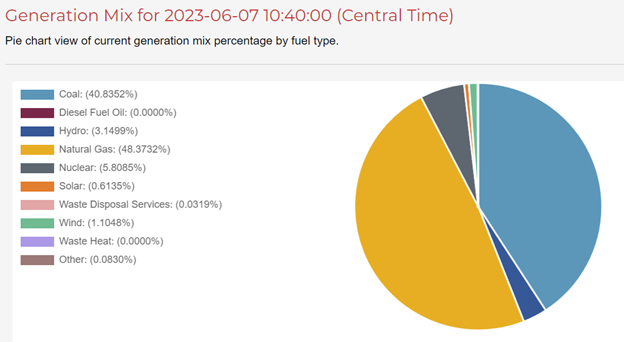
On June 7, 2023, any power coming from SaskPower’s Southwest Power Pool interconnect, south of Estevan, would have been 40.8 per cent coal, 48.4 per cent natural gas, and 1.1 per cent wind. Southwest Power Pool
Pipeline Online: SaskPower references increasing interconnects by 1,000 megawatts. We’ve already signed up for 650 megawatts with the Southwest Power Pool. Where’s the rest coming from? And what about the fact the SPP at times uses coal for over 40% of its generation? Are we exporting our coal jobs to the US with this connection?
Dustin Duncan: No, we’re not. Through the RFQ process with the SPP, what would we would be requiring is that any generation that we would be purchasing from the SPP would not be from coal generation, so we’re not exporting coal jobs to the United States.
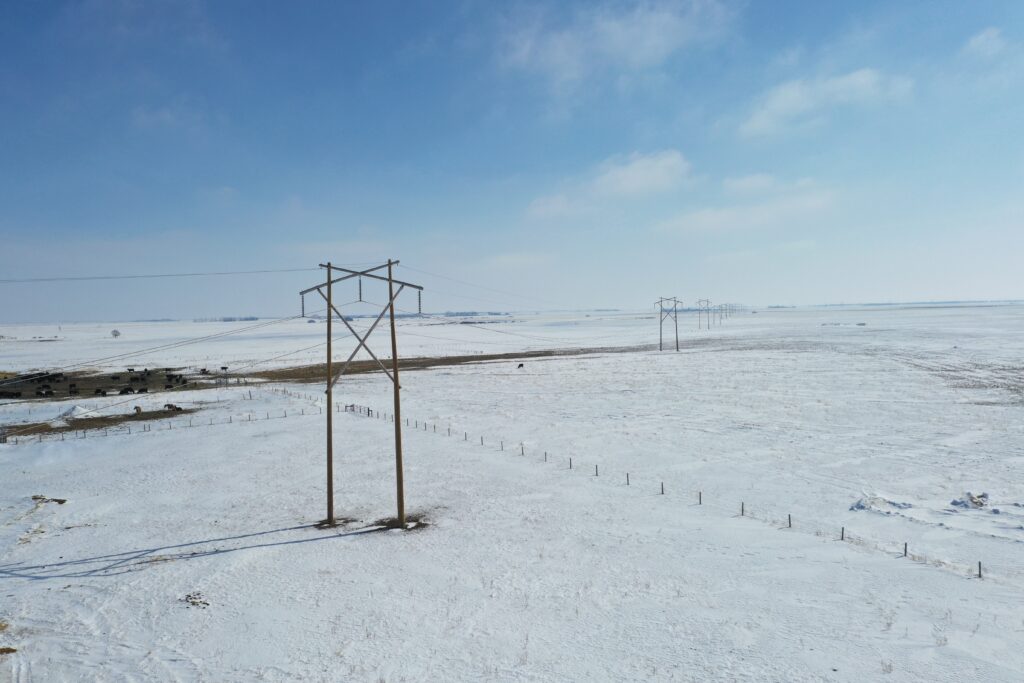
SaskPower has long had a 150 megawatt interconnect with North Dakota, seen above. The horizon is North Dakota. SaskPower will soon build a 650 megawatt interconnect, about the capacity of Boundary Dam Power Station, connecting with the Southwest Power Pool. Photo by Brian Zinchuk
The other part to this though, is that a lot of this has been looked at through the lens of importing power. There’s also significant opportunities for Saskatchewan to, which we already do, export power, but export on a larger scale. And so, I think that there are again there are significant opportunities depending on how we proceed with our generation in the potential for SMRs and large scale (nuclear) that that we could be in a very good position to actually export, and not simply important.
Pipeline Online: Even if you signed agreements with say wind generators in North Dakota or South Dakota, and electron doesn’t care what agreement you signed, it’s just based on the percentage of power in that grid.
Dustin Duncan: Right, but we’d be purchasing through the RFQ direct energy direct from where it would be produced. So there are provisions in the RFQ that that would require that.
Editor’s note: the two following stories provide the full script of the letter Duncan and SaskPower president and CEO Rupen Pandya submitted to the federal government.
- 0108 Steffes Auctioners Western Canadian Pipeline0108 Steffes Auctioners Western Canadian Pipeline
- 0107 Steffes Auctioners Western Canadian Pipeline Completion0107 Steffes Auctioners Western Canadian Pipeline Completion
- 0106 SASPO-2874_Self Serve Campaign_New Connects_Youtube_v30106 SASPO-2874_Self Serve Campaign_New Connects_Youtube_v3
- 0105 SaskEnergy Commitment to Safety0105 SaskEnergy Commitment to Safety
- 0102 Lori Carr Coal Extended0102 Lori Carr Coal Extended
- 0100 Turnbull Project Manager0100 Turnbull Project Manager
- 0099 Mryglod Steel 1080p0099 Mryglod Steel 1080p
- 0097 Eagle Sky Ventures LTD0097 Eagle Sky Ventures LTD
- 0095 Fast Trucking nearly 70 years good at it0095 Fast Trucking nearly 70 years good at it
- 0092 Turnbull projects big and small0092 Turnbull projects big and small
- 0046 City of Estevan This is Estevan Teaser0046 City of Estevan This is Estevan Teaser
- 0077 Caprice Resources Stand Up For Free Speech0077 Caprice Resources Stand Up For Free Speech
- 0061 SIMSA 2024 For Sask Buy Sask0061 SIMSA 2024 For Sask Buy Sask
- 0051 JML Hiring Pumpjack assembly0051 JML Hiring Pumpjack assembly
- 0049 Scotsburn Dental soft guitar0049 Scotsburn Dental soft guitar
- 0041 DEEP Since 2018 now we are going to build0041 DEEP Since 2018 now we are going to build
- 0032 IWS Summer hiring rock trailer music
- 0022 Grimes winter hiring
- 0021 OSY Rentals S8 Promo
- 0018 IWS Hiring Royal Summer
- 0013 Panther Drilling PO ad 03 top drive rigs
- 0002 gilliss casing services0002 gilliss casing services
- 9002 Pipeline Online 30 sec EBEX9002 Pipeline Online 30 sec EBEX
- 9001
https://pipelineonline.ca/saskpower-response-clean-electricity-regulations/
Pipeline Online provides the in-depth coverage on energy issues in this province that no other media comes close to. It does NOT receive federal journalism subsidies, and it will NOT allow the federal government to limit its freedom of speech, as it is now moving to regulate podcasts. With recent action from Facebook to block news links, it’s important to follow Pipeline Online in other manners. The easiest is to check each morning at PipelineOnline.ca, with the top story posted at 7 a.m. Monday to Friday, and additional coverage throughout the day and weekend. But you can also follow on LinkedIn and Twitter. You can follow editor Brian Zinchuk online at LinkedIn as well (you’ll see more stories that way). You can subscribe to a weekly newsletter. And if you wish to advertise and support this journalism, call 306-461-5599.
